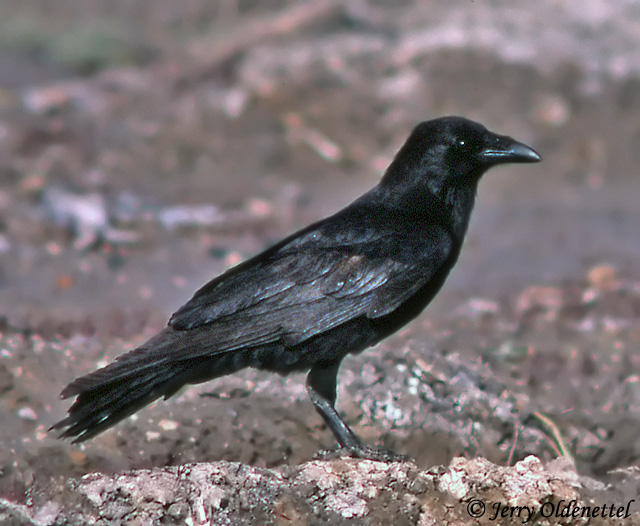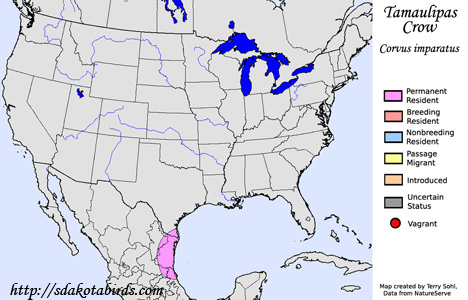| Length: 14.5 inches | Wingspan: 30 inches | Seasonality: Non-resident in South Dakota |
| ID Keys: Geographic range, black plumage with glossy bluish tone on adults, relatively small bill. | ||
 The
Tamaulipas Crow is a small crow species with a small geographic range
covering a small part of northern Mexico and extreme southern Texas.
In the Untied States, they are most often found during the winter months at
the garbage dump in Brownsville, Texas, making this particular garbage dump
an unusually popular birding location! The only other crow or raven in
its range is the much larger Chihuahuan Raven, which also can be found at
the Brownsville garbage dump in the winter. The Sinaloa Crow that
lives in western Mexico was once considered the same species as the
Tamaulipas Crow, and they were called the "Mexican Crow".
The
Tamaulipas Crow is a small crow species with a small geographic range
covering a small part of northern Mexico and extreme southern Texas.
In the Untied States, they are most often found during the winter months at
the garbage dump in Brownsville, Texas, making this particular garbage dump
an unusually popular birding location! The only other crow or raven in
its range is the much larger Chihuahuan Raven, which also can be found at
the Brownsville garbage dump in the winter. The Sinaloa Crow that
lives in western Mexico was once considered the same species as the
Tamaulipas Crow, and they were called the "Mexican Crow".
Habitat: In the United States, they are mostly found in the vicinity of the Brownsville garbage dump. In the rest of their range, they are found in a variety of open and semi-open habitats, including agricultural land, suburban areas, arid brushland and grasslands, and open savannahs.
Diet: Omnivorous, feeding on a variety of items, including insects, fruits, berries, nuts, and occasionally small vertebrates. They also will feed on refuse and carrion.
Behavior: Foraging behavior depends upon location and available food items. Most foraging is done by walking on the ground.
Nesting: The nest of a Tamaulipas Crow is a large depressed platform built of sticks and stiff plant fibers, with a lining of softer vegetative material. The female usually lays 4 eggs, and she alone incubates them. When the eggs hatch, both parents help tend to the youngsters, who leave the nest after about 18 days.
Song: Has a croaking call
Migration: Considered a permanent resident throughout its normal range, but those found in the United States are mostly found during the winter months.
Interactive eBird Map: Click here to access an interactive eBird Map of Tamaulipas Crow sightings
Similar Species: The only other crow or raven in its natural range is the Chihuahuan Raven, which is much larger with a stout thick bill.
Conservation Status: Populations are stable, and they are relatively common in parts of their range. The IUCN lists the Tamaulipas Crow as a species of "Least Concern".
Further Information: 1) Texas Breeding Bird Atlas - Tamaulipas Crow
2) BirdLife International - Tamaulipas Crow
3) Geobirds.com - Tamaulipas Crow
Photo Information: Photo taken by Jerry Oldenettel - January 18th, 2010 - Brownsville Dump in Texas - Photo licensed under Creative Commons Attribution NonCommercial Sharealike 2.0 Generic License.
| Click below for a higher-resolution map |
 |
| South Dakota Status: Non-resident in South Dakota |
Additional Tamaulipas Crow Photos (coming soon!!)
